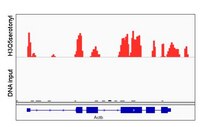Histone serotonylation is a permissive modification that enhances TFIID binding to H3K4me3.
Farrelly, LA; Thompson, RE; Zhao, S; Lepack, AE; Lyu, Y; Bhanu, NV; Zhang, B; Loh, YE; Ramakrishnan, A; Vadodaria, KC; Heard, KJ; Erikson, G; Nakadai, T; Bastle, RM; Lukasak, BJ; Zebroski, H; Alenina, N; Bader, M; Berton, O; Roeder, RG; Molina, H; Gage, FH; Shen, L; Garcia, BA; Li, H; Muir, TW; Maze, I
Nature
567
535-539
2019
Abstract anzeigen
Chemical modifications of histones can mediate diverse DNA-templated processes, including gene transcription1-3. Here we provide evidence for a class of histone post-translational modification, serotonylation of glutamine, which occurs at position 5 (Q5ser) on histone H3 in organisms that produce serotonin (also known as 5-hydroxytryptamine (5-HT)). We demonstrate that tissue transglutaminase 2 can serotonylate histone H3 tri-methylated lysine 4 (H3K4me3)-marked nucleosomes, resulting in the presence of combinatorial H3K4me3Q5ser in vivo. H3K4me3Q5ser displays a ubiquitous pattern of tissue expression in mammals, with enrichment observed in brain and gut, two organ systems responsible for the bulk of 5-HT production. Genome-wide analyses of human serotonergic neurons, developing mouse brain and cultured serotonergic cells indicate that H3K4me3Q5ser nucleosomes are enriched in euchromatin, are sensitive to cellular differentiation and correlate with permissive gene expression, phenomena that are linked to the potentiation of TFIID4-6 interactions with H3K4me3. Cells that ectopically express a H3 mutant that cannot be serotonylated display significantly altered expression of H3K4me3Q5ser-target loci, which leads to deficits in differentiation. Taken together, these data identify a direct role for 5-HT, independent from its contributions to neurotransmission and cellular signalling, in the mediation of permissive gene expression. | 30867594
 |










